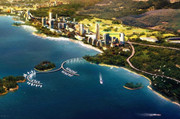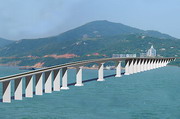Basic information
( chinadaily.com.cn )
|
|||||||||
Pingtan is sometimes called "Lan for short. It has other nicknames such as "Haitan" or "Haishan", which mean "a mountain in the sea". Pingtan is the closest region on the Chinese mainland to Taiwan, only 68 miles away from Hsinchu, Taiwan.
Pingtan consists of 126 islets and nearly 1,000 ledges. The main island, Haitan Island, looks like a kylin, an imaginary lucky animal in ancient China. For that reason, it is also called "Kylin Island".
It is the fifth largest island in China and the largest in Fujian, covering an area 2.3 times as large as Xiamen Island. It faces the Taiwan Straits to its east, Haitan Straits to its west, Southern Putian Island to its south and Baiquan Island Chain to its north. It neighbors Changle city, Fuqing city and Putian city. Pingtan covers a land area of 392.92 square kilometers and a sea area of 6,064 square kilometers. It has a population of 400,000.
Historically, Pingtan was a freight transfer station for sea trade between the southeastern Chinese mainland and Taiwan. It was opened as one of five trading ports with Taiwan during the reign of Emperor Xianfeng in the Qing Dynasty (1644-1911).
Since 1978, when China adopted the policy of reform and opening-up, Pingtan has served as a freight station to receive Taiwan ships and an area that conducts petty trade with Taiwan. Among all counties and cities, Pingtan has exported the largest number of fishermen to Taiwan.
On May 14, 2009, the State Council issued the Suggestions on Supporting Fujian to Speed up the Building of the Western Taiwan Straits Economic Zone. The document proposed that, based on present policies for special customs supervision zones, more favorable policies should be considered for islands along Fujian's coastal areas for better cooperation across the Straits.
At the end of July 2009, the sixth plenary session of the eighth Fujian Provincial CPC Committee Conference decided to set up the Fuzhou (Pingtan) Comprehensive Pilot Zone, or Pingtan Comprehensive Pilot Zone in short.
In March 2011, the State Council approved the Development Plan on the Western Taiwan Straits Economic Zone that mapped out the opening-up and development of the Pingtan Comprehensive Pilot Zone.
On December 15, 2011, upon approval by the State Council, the National Development and Reform Committee officially issued the Overall Development Plan of the Pingtan Comprehensive Pilot Zone, in which more favorable policies were granted to Pingtan in terms of customs clearance models, finance and taxation, investment access, finance and insurance, and cooperation with Taiwan.






